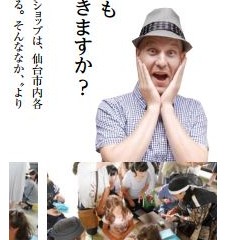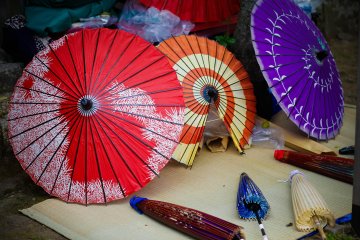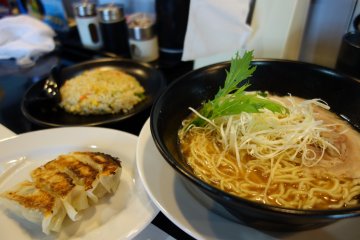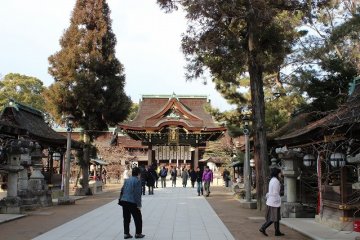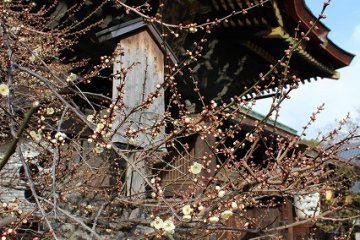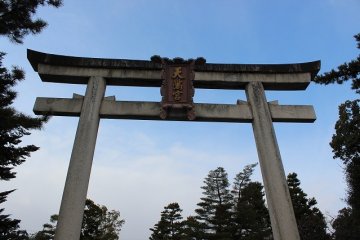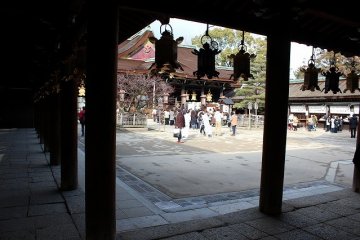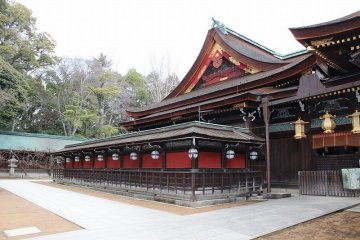When an east wind blows, it is impossible not to associate the aroma of peach trees with springtime.
It was the 4th year of Shoutai (901), the second month of the lunar calendar. Sugawara no Michizane was assigned the undesirable post of Daizaifu in modern-day Kyushu. The day before he left his home in the then capital of Kyoto, he looked at the proud white plum tree in his garden and composed a poem. MIchizane was especially fond of cherry, pine, and plum trees, grieving when the trees showed signs of death. He was most depressed when the cherry tree leaves fell.
At that point, the remaining pine and plum trees flew into the sky, or so legend says. With all their might, the jumping pine trees landed in the Suma Ward of Hyogo Prefecture while the jumping plum trees found their new home in front of the main building of the Dazaifu Shrine.
Michizane was a prodigy, his intelligence being recognized from early on in his childhood. He excelled in both academics and politics and quickly rose through the ranks of whatever he participated in. He was also quite the sportsman, considered particularly skillful with the bow and arrow. A mild-mannered person with a great personality, he was endeared by many people. Despite his obvious capabilities to do so, the scholar inside him was too proud to discuss things such as war strategy. He was known as a pure person.
It isn't hard to imagine that Michizane had many political opponents with their own conflicting agendas. The laws of the land had not been fully developed yet at that time. The period was the so-called crucible of aristocracy. Politics consisted of a balance of power and influence, both past and present.
At that time the current emperor, Emperor Uda, favored Michizane. The emperor appreciated Michizane's abilities and therefore appointed him to key government positions. However, the emperor had also appointed Kuge Fujiwara (Tokihira) to a similar position. In reality, the Fujiwara clan had real authority while the reigning emperor was something like a puppet during the time. By handpicking the Fujiwara member, the emperor ensured the peaceful era Michizane knew would come to a close.
When passing through the first tori gate of Kitano-Tenmangu Shrine, there are shining statues of resting cows. There's an oral history about the animals.
After the death of Michizane, his body was to be transported by ox cart to the northeast around the Dazaifu-Mikasa area. However, in transit the cart suddenly stopped in front of Anraku Temple.The cattle wouldn't budge. One of Sugawara no Michizane's disciples, Umasake no Yasuyuki, decided to bury the body there. Michizane was enshrined at the shrine built there soon after. This became the beginning of Dazaifu in Kitakyushu.
The reason why cow images have been used and worshipped at Tenmangu shrines around the country relates to the above story. I also rubbed the back of an obsidian cow image on my way to the main hall.
Emperor Uda, from his elegant villa and lifestyle outside the Imperial Palace said to Michizane "We need someone capable of managing the capital and that is why we have our current political system in place." Fujiwara Tokihira continued his position uninterrupted. He made lots of money doing so. Tokihira created a manor development ordinance, consolidated finances, and made friends with shrewd politicians. Tokihira was the unprecedented notorious playboy, while Michizane was the serious scholar. Everyone was thinking the same thing, but people were divided over political procedures.
Tokihira was preoccupied with his own jealousy. As long as Michizane was in the picture, Tokihira would always have to settle for being number two. As a political opponent, Michizane habitually debated and conquered any challengers. However, Tokihira still had one advantage: the emperor was still his puppet. There was pride and a longing for the rightful government to have real power. While the political stage centered on Tokihira and Michizane locked in combat, the feud between Emperor Uda and Emperor Daigo once again heated up red hot. Emperor Uda eventually resigned under pressure, forfeiting his position to Emperor Daigo. Power returned to the emperor.
Emperor Daigo said to the nobles in his court, "Emperor Uda's behavior was outrageous. Still, if I, Emperor Daigo, am not the reigning emperor, Michizane would cause just as much trouble." The words were well received by those in attendance. However, there was another reason for this conspiracy: money. There was a theory Michizane was budgeting for the central government. However, at this time the Fujiwara family was still in control of the government so Michizane could not have been involved. In the year 900 on an autumn evening, Tokihira went against his original promise and betrayed Emperor Daigo. Michizane is attached to the imperial son to the throne of Emperor Uda. So in order to give the throne to Prince Tokio, they began plotting a rebellion to take over as ruler from Emperor Daigo.
The plan drawn up by Tokihira was for Michizane to uselessly try explain his innocence, and then to be banished to Dazaifu, which had already been predetermined. The retired Emperor Uda admired Michizane, so upon hearing of this plot, was determined to hastily meet Emperor Daigo. However, Daigo rejected the request. Not only that, but he punished Michizane by exiling his four children.
Michizane's request had been rejected and he was forced to spend a miserable life in Dazaifu until his death. He died at the age of 59. From that point the city of Kyoto seemed to be in a state of panic.
At Mt. Hiei's Enryaku Temple, the 13th generation head priest saw a manifestation of Michizane appear in his dream. The ghost of Michizane said "I will curse those who decieved me, but will help those who tried to assist me." Fujiwara no Sadakuni, a person who had joined the consiracy against Michizane, had a sudden death at the young age of 40 in 906. Fujiwara no Sugane, a person who prevented Emperor Uda from helping Michizane, was struck by lightning and instantly killed in the year 908. Witnessing these events, Tokihira went insane and died in 909.
Snakes crawled out from the ears of Tokihira's dead body.Despite hearing Michizane's ghost approaching from behind and being unable to move from fear, it is said a shaman threw some incense sticks before escaping.
A prince of Emperor Daigo, Prince Yasuakira, also experienced sudden death at the age of 21 in the year 923. Then the child prince of Prince Yasuaki, Prince Yoshiyoriou, died at the age of 5 in 925. Eventually, Emperor Daigo also died from madness at 41 years old in 930. Most days the court the court was trembling in fear. It was thought the ghost of Michizane was causing a number of natural disasters via the god of thunder.
To calm the spirit of Michizane, the Kitano Tenmangu Shrine was constructed. It seemed the thunder god's anger subsided. Today this enshrined deity of scholarship helps those wishing to pass examinations.


